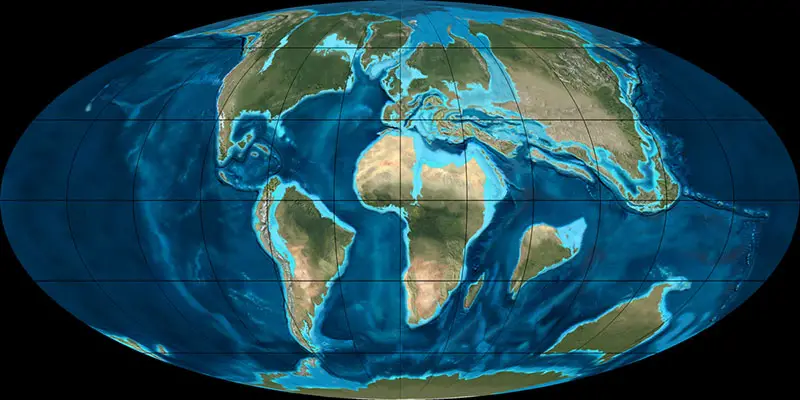†Picrodontidae
Picrodontidae ist der Familienname von 13 Primaten, die ab dem frühen Paläogen (Paläozän) im Danium vor 66 Millionen Jahren bis 61,6 Millionen Jahren lebten. Viele Überreste wurden in Vereinigte Staaten von Amerika (USA) gefunden.
Zur Familie Picrodontidae (Klade Euprimateformes) zählt man drei Gattungen von frühen Primaten, die nur durch fossile Zähne aus dem Westen Nordamerikas aus der Zeit des mittleren und späten Paläozän bekannt sind.
Die Mitglieder der Familie Picrodontidae ähneln anderen Euprimateformes in der Morphologie der Schneidezähne, jedoch sind die Backenzähne ziemlich ungewöhnlich, denn die ersten oberen und unteren Molaren sind vergrößert und haben eine ungewöhnliche Form.
| Physiologie | |
|---|---|
| Gewicht: | ? |
| Schwestertaxa | |
Literatur
G. G. Simpson 1935, The Tiffany fauna, Upper Paleocene. 1, Multituberculata, Marsupialia, Insectivora, and ?Chiroptera. American Museum Novitates. 795, p. 1 - 19G. G. Simpson 1937, The Fort Union of the Crazy Mountain field, Montana and its mammalian faunas. Bulletin of the United States National Museum. 169, p. 1 - 287
J. K. Rigby, Jr. 1980, Swain Quarry of the Fort Union Formation, Middle Paleocene (Torrejonian), Carbon County, Wyoming: geologic setting and mammalian fauna. Evolutionary Monographs. 3, p. 1 - 178
M. C. McKenna 1980, Late Cretaceous and Early Tertiary vertebrate paleontological reconnaissance, Togwotee Pass area, northwestern Wyoming. Aspects of Vertebrate History: Essays in Honor of Edwin Harris Colbert, L. L. Jacobs (ed.), Museum of Northern Arizona Press. , p. 323 - 343
K. D. Rose 1981, The Clarkforkian Land-Mammal Age and Mammalian Faunal Composition Across the Paleocene-Eocene Boundary. University of Michigan Papers on Paleontology. 26, p. 1 - 197
G. F. Winterfeld 1982, Mammalian paleontology of the Fort Union Formation (Paleocene), eastern Rock Springs Uplift, Sweetwater County, Wyoming. Contributions to Geology, University of Wyoming. 21:1, p. 73 - 112
Y. Tomida 1982, A New Genus of Picrodontid Primate from the Paleocene of Utah. Folia Primatologica. 37:1, p. - 112
L. N. Robinson, J. G. Honey 1987, Geologic setting of a new Paleocene mammal locality in the northern Powder River basin, Montana. Palaios. 2:1, p. 87 - 90
R. C. Fox, J. G. Honey 1988, Late Cretaceous and Paleocene mammal localities of southern Alberta. Occasional Paper of the Tyrrell Museum of Palaeontology. 6:1, p. 1 - 38
R. C. Fox, J. G. Honey 1990, The succession of Paleocene mammals in western Canada. Geological Society of America Special Paper. 243:1, p. 51 - 70
D. W. Krause, M. C. Maas 1990, The biogeographic origins of late Paleocene - early Eocene mammalian immigrants to the Western Interior of North America. Geological Society of America Special Paper. 243:1, p. 71 - 105
C. S. Scott, R. C. Fox 2005, Windows on the evolution of Picrodus (Plesiadapiformes: Primates): morphology and relationships of a species complex from the Paleocene of Alberta. Journal of Paleontology. 79:4, p. 635 - 657
B. J. Burger, R. C. Fox 2013, A new species of the archaic primate Zanycteris from the late Paleocene of western Colorado and the phylogenetic position of the family Picrodontidae. PeerJ. 1:4, p. e191:1 - 11, DOI: 10.7717/peerj.191
E. De Bast, T. Smith 2017, The oldest Cenozoic mammal fauna of Europe: implication of the Hainin reference fauna for mammalian evolution and dispersals during the Paleocene. Journal of Systematic Palaeontology. 15:9, p. 741 - 785, DOI: 10.1080/14772019.2016.1237582
